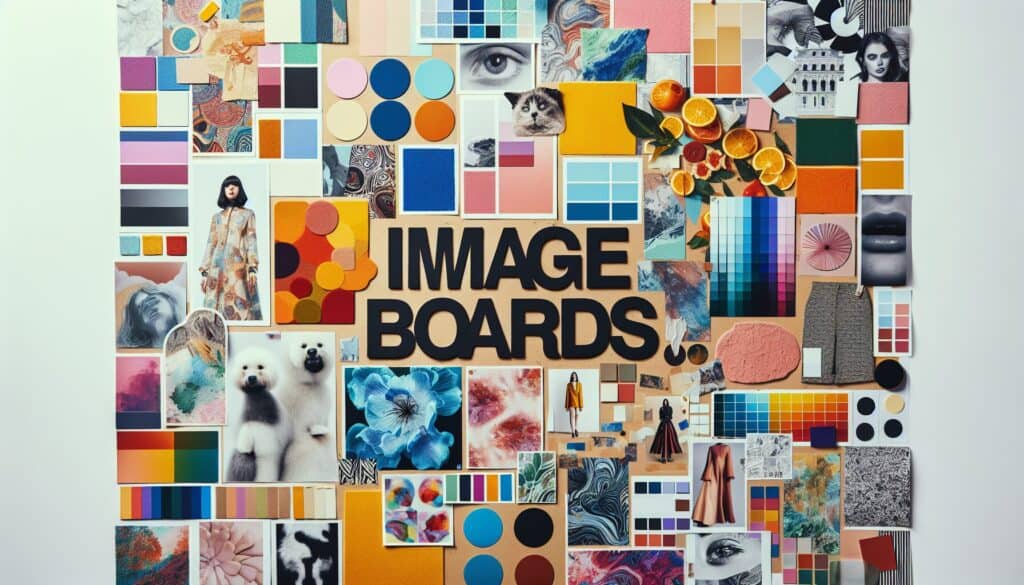Esplorare visivamente e comunicare l'estetica, lo stile, il tono emotivo e la direzione generale desiderati per un progetto o un prodotto creativo.
- Metodologie: Clienti e marketing, Ideazione, Progettazione del prodotto
Schede di immagini (Mood Boards)

Schede di immagini (Mood Boards)
- Strategie di branding, Strategie di design creativo, Pensiero progettuale, Human-Centered Design, Ideazione, Prototipazione, Esperienza utente (UX), Interfaccia utente (UI), Design visivo
Obiettivo:
Come si usa:
- Un collage di immagini, texture, colori, tipografia e altri elementi visivi che rappresentano collettivamente l'aspetto e l'atmosfera desiderati. Viene utilizzato come strumento di ispirazione e comunicazione all'interno di un team di progettazione e con le parti interessate.
Professionisti
- Facilita l'esplorazione creativa e l'ideazione, aiuta a stabilire una chiara identità visiva fin dalle prime fasi, migliora la comunicazione e l'allineamento sugli obiettivi estetici, può ispirare nuove direzioni progettuali.
Contro
- Possono essere interpretati in modo errato se non sono ben curati o spiegati, possono portare a progetti eccessivamente derivativi se le tavole sono troppo restrittive, la creazione può richiedere molto tempo, l'efficacia dipende dalla qualità e dalla rilevanza delle immagini scelte.
Categorie:
- Clienti e marketing, Ideazione, Progettazione del prodotto
Ideale per:
- Le prime fasi dei progetti di design (grafica, interior design, moda, product design, branding) per definire e comunicare la direzione visiva ed emotiva.
Image boards, commonly known as mood boards, play a significant role in bridging the gap between abstract concepts and tangible design in various industries. They are frequently employed during the ideation phase of projects in sectors such as graphic design, interior design, fashion, and product development, where visual aesthetics are paramount. In practice, team members from different disciplines, including designers, marketers, and engineers, collaboratively gather inspiration—ranging from color palettes to materials and typography—to establish a shared vision that aligns with the project’s goals and user expectations. For instance, in product design, a mood board may integrate textures and visual materials that reflect the desired user experience, informing the tactile qualities of the final product. The iterative nature of mood boards allows participants to experiment with styles and elements without significant investment in resources, encouraging creativity and innovation. By providing a concrete reference point, they facilitate discussions around aesthetic choices, ensuring that stakeholders remain aligned on the project’s visual narrative and emotional resonance. This collaborative tool not only enhances the initial creative phase but can also serve as a benchmark for evaluating design decisions throughout the project lifecycle, ensuring that the resultant design remains consistent with the established visual identity. As such, these boards are valuable in scenarios where initial ideas need to be communicated effectively to clients, investors, or team members, ensuring that everyone involved has a unified understanding of the creative direction.
Fasi chiave di questa metodologia
- Identify core themes and concepts relevant to the project.
- Gather visual elements such as images, textures, and colors that resonate with those themes.
- Curate and arrange selected visuals into a cohesive layout.
- Refine the arrangement to enhance communication of the desired emotional and visual direction.
- Present the mood board to stakeholders for feedback and alignment on aesthetic goals.
- Iterate on the mood board based on received feedback to ensure relevance and clarity.
- Use the finalized mood board as a guide throughout the design process.
Suggerimenti per i professionisti
- Incorporate user-generated content or existing design artifacts to ensure authenticity and relevance to user needs.
- Utilize a digital platform for collaborative mood board creation, allowing real-time feedback and iterative development from varied team members.
- Create multiple iterations of mood boards throughout the design process to adapt and reflect evolving project goals and stakeholder input.
Leggere e confrontare diverse metodologie, raccomandiamo il
> Ampio archivio di metodologie <
insieme ad altre 400 metodologie.
I vostri commenti su questa metodologia o ulteriori informazioni sono benvenuti su sezione commenti qui sotto ↓ , così come tutte le idee o i link relativi all'ingegneria.
Contesto storico
1986
(se la data non è nota o non è rilevante, ad esempio "meccanica dei fluidi", viene fornita una stima approssimativa della sua notevole comparsa)

Post correlati
Simulazione di Monte Carlo
Test basati su modelli
Controllo del modello
Ricerca con metodi misti
A prova di errore (Poka-Yoke)
Test del profilo di missione